Swedish vs Cherokee Community Comparison
COMPARE
Swedish
Cherokee
Social Comparison
Social Comparison
Swedes
Cherokee
8,881
SOCIAL INDEX
86.3/ 100
SOCIAL RATING
41st/ 347
SOCIAL RANK
2,697
SOCIAL INDEX
24.5/ 100
SOCIAL RATING
243rd/ 347
SOCIAL RANK
Cherokee Integration in Swedish Communities
The statistical analysis conducted on geographies consisting of 471,042,063 people shows a substantial positive correlation between the proportion of Cherokee within Swedish communities in the United States with a correlation coefficient (R) of 0.501. On average, for every 1% (one percent) increase in Swedes within a typical geography, there is an increase of 0.081% in Cherokee. To illustrate, in a geography comprising of 100,000 individuals, a rise of 1,000 Swedes corresponds to an increase of 81.4 Cherokee.
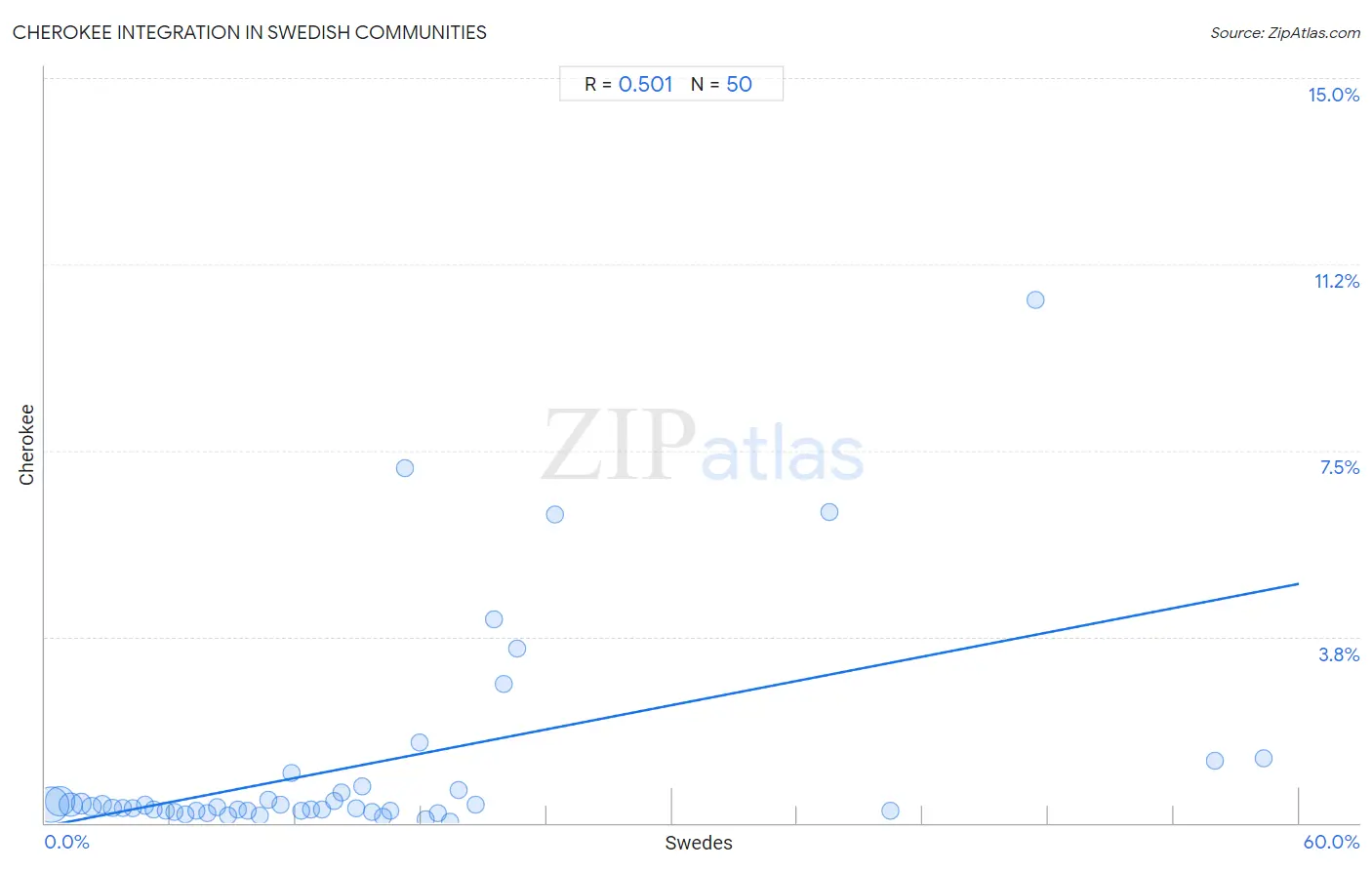
Swedish vs Cherokee Income
When considering income, the most significant differences between Swedish and Cherokee communities in the United States are seen in householder income ages 45 - 64 years ($106,377 compared to $86,125, a difference of 23.5%), median family income ($108,499 compared to $88,209, a difference of 23.0%), and per capita income ($45,750 compared to $37,203, a difference of 23.0%). Conversely, both communities are more comparable in terms of wage/income gap (29.4% compared to 27.4%, a difference of 7.3%), householder income under 25 years ($52,986 compared to $47,848, a difference of 10.7%), and median female earnings ($39,421 compared to $34,742, a difference of 13.5%).

| Income Metric | Swedish | Cherokee |
| Per Capita Income | Exceptional $45,750 | Tragic $37,203 |
| Median Family Income | Exceptional $108,499 | Tragic $88,209 |
| Median Household Income | Exceptional $88,524 | Tragic $72,682 |
| Median Earnings | Excellent $47,851 | Tragic $41,252 |
| Median Male Earnings | Exceptional $57,445 | Tragic $48,669 |
| Median Female Earnings | Fair $39,421 | Tragic $34,742 |
| Householder Age | Under 25 years | Excellent $52,986 | Tragic $47,848 |
| Householder Age | 25 - 44 years | Exceptional $99,136 | Tragic $80,843 |
| Householder Age | 45 - 64 years | Exceptional $106,377 | Tragic $86,125 |
| Householder Age | Over 65 years | Excellent $62,736 | Tragic $54,133 |
| Wage/Income Gap | Tragic 29.4% | Tragic 27.4% |
Swedish vs Cherokee Poverty
When considering poverty, the most significant differences between Swedish and Cherokee communities in the United States are seen in married-couple family poverty (3.9% compared to 5.8%, a difference of 49.5%), family poverty (7.1% compared to 10.6%, a difference of 48.8%), and child poverty under the age of 16 (13.3% compared to 19.5%, a difference of 46.6%). Conversely, both communities are more comparable in terms of female poverty among 18-24 year olds (20.1% compared to 22.7%, a difference of 12.8%), seniors poverty over the age of 75 (10.2% compared to 12.0%, a difference of 18.4%), and single father poverty (16.3% compared to 19.6%, a difference of 20.5%).
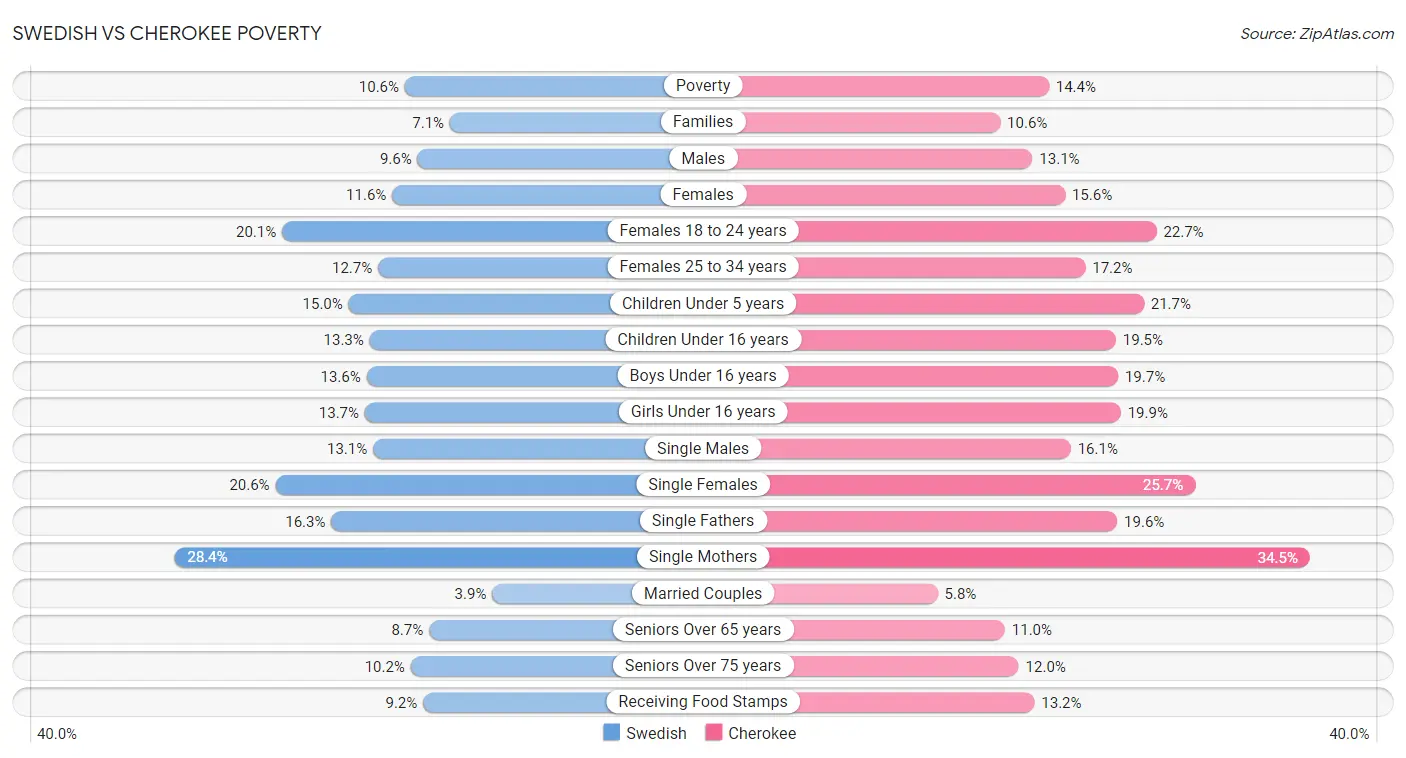
| Poverty Metric | Swedish | Cherokee |
| Poverty | Exceptional 10.6% | Tragic 14.4% |
| Families | Exceptional 7.1% | Tragic 10.6% |
| Males | Exceptional 9.6% | Tragic 13.1% |
| Females | Exceptional 11.6% | Tragic 15.6% |
| Females 18 to 24 years | Average 20.1% | Tragic 22.7% |
| Females 25 to 34 years | Exceptional 12.7% | Tragic 17.2% |
| Children Under 5 years | Exceptional 15.0% | Tragic 21.7% |
| Children Under 16 years | Exceptional 13.3% | Tragic 19.5% |
| Boys Under 16 years | Exceptional 13.6% | Tragic 19.7% |
| Girls Under 16 years | Exceptional 13.7% | Tragic 19.9% |
| Single Males | Poor 13.1% | Tragic 16.1% |
| Single Females | Good 20.6% | Tragic 25.7% |
| Single Fathers | Average 16.3% | Tragic 19.6% |
| Single Mothers | Excellent 28.4% | Tragic 34.5% |
| Married Couples | Exceptional 3.9% | Tragic 5.8% |
| Seniors Over 65 years | Exceptional 8.7% | Average 11.0% |
| Seniors Over 75 years | Exceptional 10.2% | Good 12.0% |
| Receiving Food Stamps | Exceptional 9.2% | Tragic 13.2% |
Swedish vs Cherokee Unemployment
When considering unemployment, the most significant differences between Swedish and Cherokee communities in the United States are seen in unemployment among women with children under 6 years (7.4% compared to 9.3%, a difference of 26.3%), unemployment among ages 35 to 44 years (4.2% compared to 5.2%, a difference of 25.0%), and unemployment among ages 30 to 34 years (5.1% compared to 6.4%, a difference of 24.2%). Conversely, both communities are more comparable in terms of unemployment among seniors over 75 years (10.0% compared to 9.8%, a difference of 1.5%), unemployment among seniors over 65 years (4.9% compared to 5.1%, a difference of 4.2%), and unemployment among ages 65 to 74 years (5.1% compared to 5.4%, a difference of 5.6%).
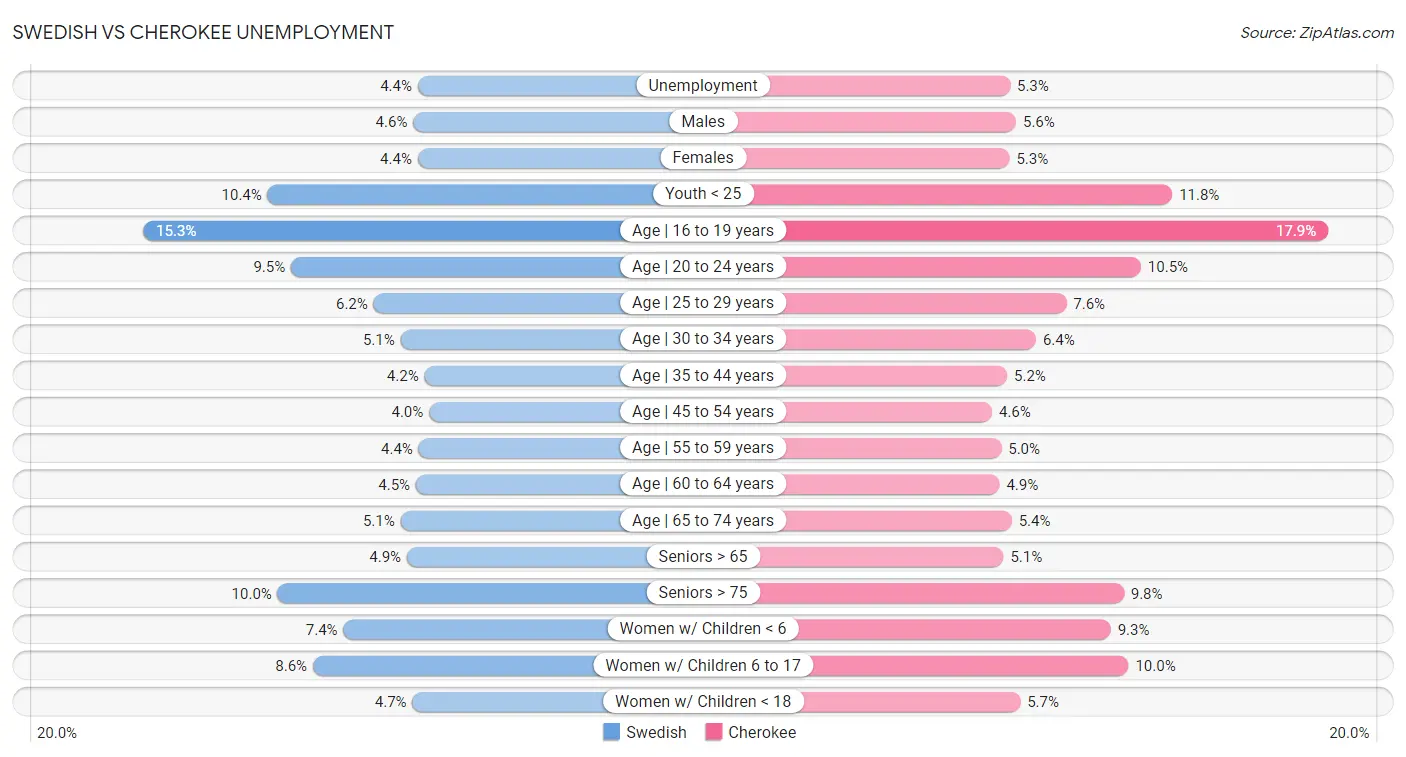
| Unemployment Metric | Swedish | Cherokee |
| Unemployment | Exceptional 4.4% | Fair 5.3% |
| Males | Exceptional 4.6% | Tragic 5.6% |
| Females | Exceptional 4.4% | Fair 5.3% |
| Youth < 25 | Exceptional 10.4% | Fair 11.8% |
| Age | 16 to 19 years | Exceptional 15.3% | Poor 17.9% |
| Age | 20 to 24 years | Exceptional 9.5% | Tragic 10.5% |
| Age | 25 to 29 years | Exceptional 6.2% | Tragic 7.6% |
| Age | 30 to 34 years | Exceptional 5.1% | Tragic 6.4% |
| Age | 35 to 44 years | Exceptional 4.2% | Tragic 5.2% |
| Age | 45 to 54 years | Exceptional 4.0% | Poor 4.6% |
| Age | 55 to 59 years | Exceptional 4.4% | Tragic 5.0% |
| Age | 60 to 64 years | Exceptional 4.5% | Poor 4.9% |
| Age | 65 to 74 years | Exceptional 5.1% | Fair 5.4% |
| Seniors > 65 | Exceptional 4.9% | Excellent 5.1% |
| Seniors > 75 | Tragic 10.0% | Tragic 9.8% |
| Women w/ Children < 6 | Excellent 7.4% | Tragic 9.3% |
| Women w/ Children 6 to 17 | Exceptional 8.6% | Tragic 10.0% |
| Women w/ Children < 18 | Exceptional 4.7% | Tragic 5.7% |
Swedish vs Cherokee Labor Participation
When considering labor participation, the most significant differences between Swedish and Cherokee communities in the United States are seen in in labor force | age 16-19 (44.1% compared to 40.2%, a difference of 9.7%), in labor force | age 45-54 (83.7% compared to 79.0%, a difference of 6.0%), and in labor force | age 20-64 (80.3% compared to 76.2%, a difference of 5.3%). Conversely, both communities are more comparable in terms of in labor force | age 20-24 (78.8% compared to 75.9%, a difference of 3.8%), in labor force | age 25-29 (85.6% compared to 82.1%, a difference of 4.3%), and in labor force | age 30-34 (85.2% compared to 81.6%, a difference of 4.4%).

| Labor Participation Metric | Swedish | Cherokee |
| In Labor Force | Age > 16 | Average 65.1% | Tragic 61.9% |
| In Labor Force | Age 20-64 | Exceptional 80.3% | Tragic 76.2% |
| In Labor Force | Age 16-19 | Exceptional 44.1% | Exceptional 40.2% |
| In Labor Force | Age 20-24 | Exceptional 78.8% | Exceptional 75.9% |
| In Labor Force | Age 25-29 | Exceptional 85.6% | Tragic 82.1% |
| In Labor Force | Age 30-34 | Exceptional 85.2% | Tragic 81.6% |
| In Labor Force | Age 35-44 | Exceptional 85.0% | Tragic 81.4% |
| In Labor Force | Age 45-54 | Exceptional 83.7% | Tragic 79.0% |
Swedish vs Cherokee Family Structure
When considering family structure, the most significant differences between Swedish and Cherokee communities in the United States are seen in single mother households (5.5% compared to 6.8%, a difference of 24.1%), births to unmarried women (29.6% compared to 36.7%, a difference of 23.7%), and divorced or separated (12.1% compared to 13.7%, a difference of 13.3%). Conversely, both communities are more comparable in terms of family households with children (27.4% compared to 27.5%, a difference of 0.45%), family households (64.5% compared to 65.0%, a difference of 0.73%), and average family size (3.10 compared to 3.18, a difference of 2.7%).

| Family Structure Metric | Swedish | Cherokee |
| Family Households | Good 64.5% | Exceptional 65.0% |
| Family Households with Children | Fair 27.4% | Average 27.5% |
| Married-couple Households | Exceptional 49.7% | Good 46.7% |
| Average Family Size | Tragic 3.10 | Tragic 3.18 |
| Single Father Households | Good 2.3% | Tragic 2.6% |
| Single Mother Households | Exceptional 5.5% | Tragic 6.8% |
| Currently Married | Exceptional 50.0% | Good 46.9% |
| Divorced or Separated | Fair 12.1% | Tragic 13.7% |
| Births to Unmarried Women | Exceptional 29.6% | Tragic 36.7% |
Swedish vs Cherokee Vehicle Availability
When considering vehicle availability, the most significant differences between Swedish and Cherokee communities in the United States are seen in no vehicles in household (6.8% compared to 7.7%, a difference of 13.9%), 2 or more vehicles in household (61.8% compared to 59.9%, a difference of 3.3%), and 4 or more vehicles in household (7.6% compared to 7.7%, a difference of 1.6%). Conversely, both communities are more comparable in terms of 3 or more vehicles in household (23.0% compared to 23.0%, a difference of 0.030%), 1 or more vehicles in household (93.3% compared to 92.4%, a difference of 1.0%), and 4 or more vehicles in household (7.6% compared to 7.7%, a difference of 1.6%).

| Vehicle Availability Metric | Swedish | Cherokee |
| No Vehicles Available | Exceptional 6.8% | Exceptional 7.7% |
| 1+ Vehicles Available | Exceptional 93.3% | Exceptional 92.4% |
| 2+ Vehicles Available | Exceptional 61.8% | Exceptional 59.9% |
| 3+ Vehicles Available | Exceptional 23.0% | Exceptional 23.0% |
| 4+ Vehicles Available | Exceptional 7.6% | Exceptional 7.7% |
Swedish vs Cherokee Education Level
When considering education level, the most significant differences between Swedish and Cherokee communities in the United States are seen in professional degree (4.5% compared to 3.3%, a difference of 37.9%), doctorate degree (2.0% compared to 1.5%, a difference of 35.9%), and master's degree (15.2% compared to 11.4%, a difference of 34.1%). Conversely, both communities are more comparable in terms of nursery school (98.7% compared to 98.3%, a difference of 0.33%), kindergarten (98.7% compared to 98.3%, a difference of 0.34%), and 1st grade (98.6% compared to 98.3%, a difference of 0.34%).
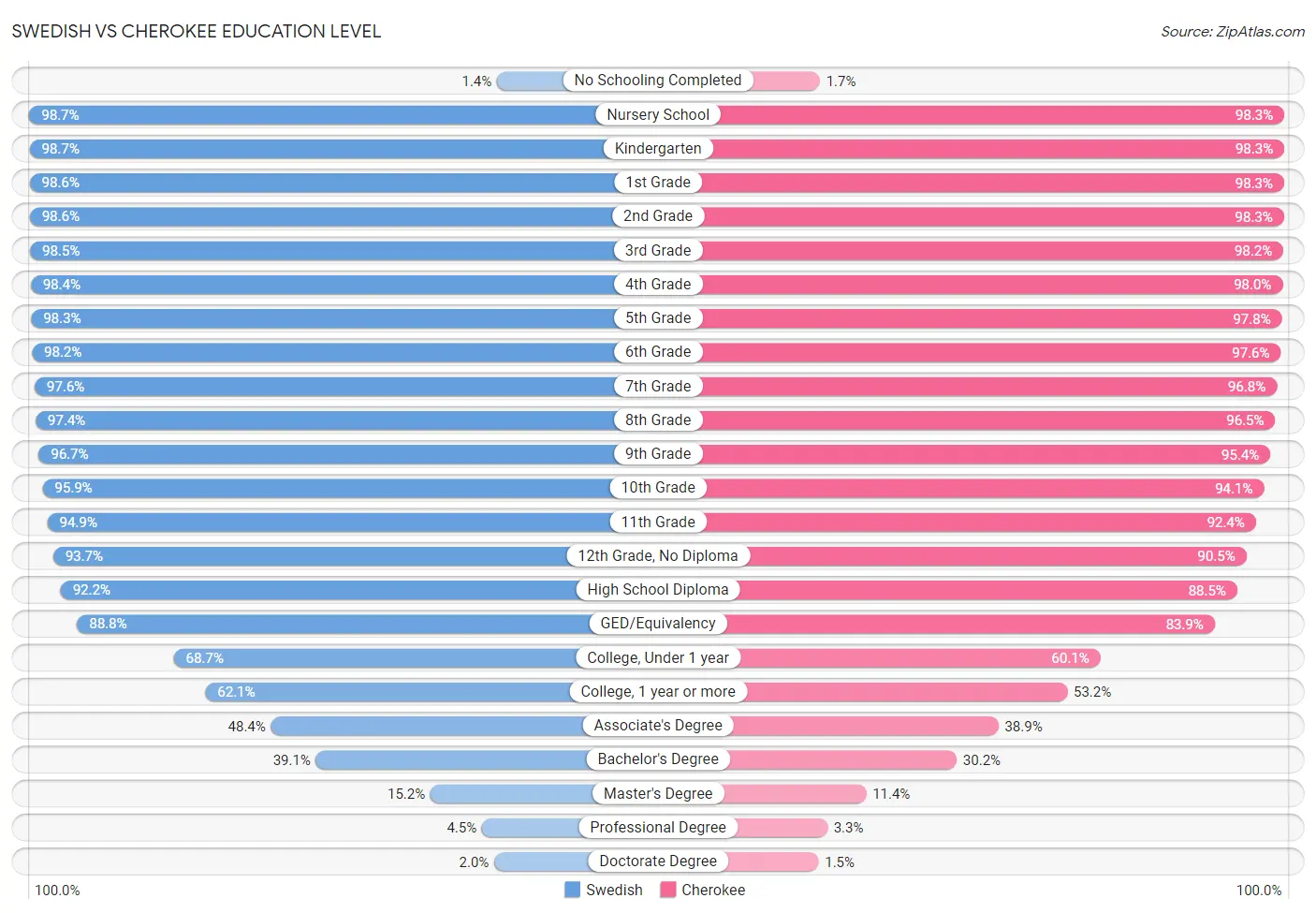
| Education Level Metric | Swedish | Cherokee |
| No Schooling Completed | Exceptional 1.4% | Exceptional 1.7% |
| Nursery School | Exceptional 98.7% | Exceptional 98.3% |
| Kindergarten | Exceptional 98.7% | Exceptional 98.3% |
| 1st Grade | Exceptional 98.6% | Exceptional 98.3% |
| 2nd Grade | Exceptional 98.6% | Exceptional 98.3% |
| 3rd Grade | Exceptional 98.5% | Exceptional 98.2% |
| 4th Grade | Exceptional 98.4% | Exceptional 98.0% |
| 5th Grade | Exceptional 98.3% | Exceptional 97.8% |
| 6th Grade | Exceptional 98.2% | Exceptional 97.6% |
| 7th Grade | Exceptional 97.6% | Exceptional 96.8% |
| 8th Grade | Exceptional 97.4% | Exceptional 96.5% |
| 9th Grade | Exceptional 96.7% | Exceptional 95.4% |
| 10th Grade | Exceptional 95.9% | Excellent 94.1% |
| 11th Grade | Exceptional 94.9% | Average 92.4% |
| 12th Grade, No Diploma | Exceptional 93.7% | Tragic 90.5% |
| High School Diploma | Exceptional 92.2% | Poor 88.5% |
| GED/Equivalency | Exceptional 88.8% | Tragic 83.9% |
| College, Under 1 year | Exceptional 68.7% | Tragic 60.1% |
| College, 1 year or more | Exceptional 62.1% | Tragic 53.2% |
| Associate's Degree | Exceptional 48.4% | Tragic 38.9% |
| Bachelor's Degree | Good 39.1% | Tragic 30.2% |
| Master's Degree | Good 15.2% | Tragic 11.4% |
| Professional Degree | Good 4.5% | Tragic 3.3% |
| Doctorate Degree | Excellent 2.0% | Tragic 1.5% |
Swedish vs Cherokee Disability
When considering disability, the most significant differences between Swedish and Cherokee communities in the United States are seen in vision disability (2.1% compared to 2.9%, a difference of 40.6%), disability age 35 to 64 (11.4% compared to 15.5%, a difference of 35.0%), and ambulatory disability (6.0% compared to 7.9%, a difference of 31.5%). Conversely, both communities are more comparable in terms of cognitive disability (16.5% compared to 18.0%, a difference of 8.8%), disability age over 75 (45.7% compared to 50.2%, a difference of 10.0%), and disability age under 5 (1.6% compared to 1.8%, a difference of 12.1%).
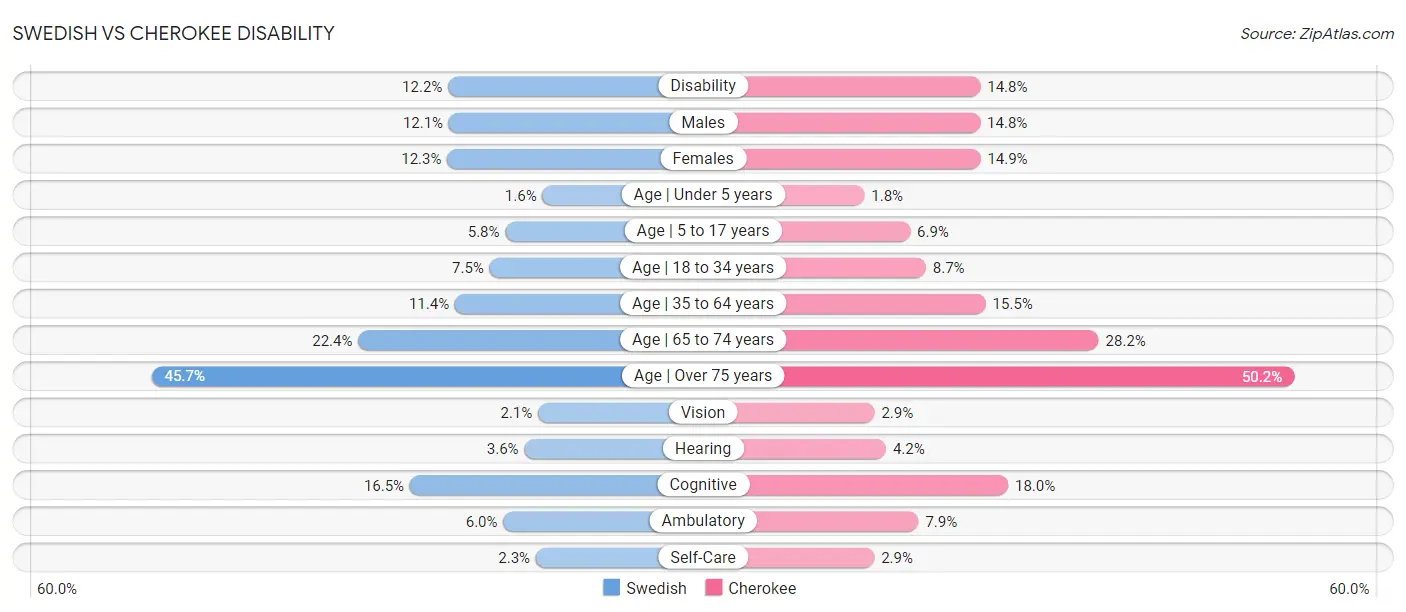
| Disability Metric | Swedish | Cherokee |
| Disability | Tragic 12.2% | Tragic 14.8% |
| Males | Tragic 12.1% | Tragic 14.8% |
| Females | Fair 12.3% | Tragic 14.9% |
| Age | Under 5 years | Tragic 1.6% | Tragic 1.8% |
| Age | 5 to 17 years | Tragic 5.8% | Tragic 6.9% |
| Age | 18 to 34 years | Tragic 7.5% | Tragic 8.7% |
| Age | 35 to 64 years | Fair 11.4% | Tragic 15.5% |
| Age | 65 to 74 years | Exceptional 22.4% | Tragic 28.2% |
| Age | Over 75 years | Exceptional 45.7% | Tragic 50.2% |
| Vision | Exceptional 2.1% | Tragic 2.9% |
| Hearing | Tragic 3.6% | Tragic 4.2% |
| Cognitive | Exceptional 16.5% | Tragic 18.0% |
| Ambulatory | Excellent 6.0% | Tragic 7.9% |
| Self-Care | Exceptional 2.3% | Tragic 2.9% |